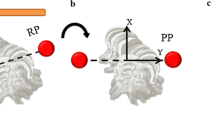Abstract.
Although analysis of scoliotic deformity is still studied extensively by means of conventional roentgenograms, computer-assisted digital analysis may allow a faster, more accurate and more complete evaluation of the scoliotic spine. In this study, a new computer-assisted measurement method was evaluated. This method uses digital reconstruction images for quantitative analysis of the scoliotic spine. The aim of the current study was to determine the reliability of the computer-assisted measuring method, which was done by establishing coefficients of repeatability for a variety of measurements. Measurements were carried out by five observers on 30 frontal and 10 lateral scoliotic digital reconstruction images. Each image was measured on three separate occasions by placing anatomical vertebral landmarks and drawing lines with a computer pointing device. The computer then calculated a number of geometrical shape parameters from scale calibration, landmarks and lines. The intra- and interobserver results were subjected to an analysis of variance to assess the level of agreement, and the means and standard deviations were calculated. The coefficient of repeatability (CR) was taken to be equal to two standard deviations. The mean intraobserver CR was found to be 3.1° for the Cobb angle on the frontal digital image and 3.3° for the kyphosis Cobb angle on the lateral overview. The mean difference in the intraobserver CR of the Cobb angle between measurements made by placing landmarks and those made by drawing lines was not statistically significant (P>0.05). The mean intraobserver CR for the other parameters can be summarized as follows: for lateral deviation it was 0.8 mm, for axial rotation 4.0° and for length of the spine 3.3 mm. The interobserver bias was negligible. It can be concluded that the reliability of our new method for quantifying geometrical variables on digital reconstruction images is better than measurements on conventional roentgenograms in previously published reports. The presented method is therefore considered to be more accurate for research of spinal deformities and more adequate for clinical management of scoliosis.
Similar content being viewed by others
Author information
Authors and Affiliations
Additional information
Electronic Publication
Rights and permissions
About this article
Cite this article
Cheung, J., Wever, D.J., Veldhuizen, A.G. et al. The reliability of quantitative analysis on digital images of the scoliotic spine. Eur Spine J 11, 535–542 (2002). https://doi.org/10.1007/s00586-001-0381-7
Received:
Revised:
Accepted:
Issue Date:
DOI: https://doi.org/10.1007/s00586-001-0381-7




